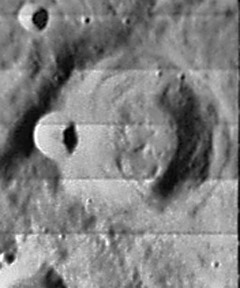Difference between revisions of "Cichus"
(Created page with "<div id="content_view" class="wiki" style="display: block"> =Cichus= {| class="wiki_table" | Lat: 33.3°S, Long: 21.1°W, Diam: 40 km, Depth: 2.76 km, [http://the-moon.wik...") |
|||
| Line 3: | Line 3: | ||
{| class="wiki_table" | {| class="wiki_table" | ||
| | | | ||
| − | Lat: 33.3°S, Long: 21.1°W, Diam: 40 km, Depth: 2.76 km, [http://the-moon. | + | Lat: 33.3°S, Long: 21.1°W, Diam: 40 km, Depth: 2.76 km, [http://the-moon.us/wiki/R%C3%BCkl%2063 Rükl: 63], [http://the-moon.us/wiki/Stratigraphy Eratosthenian]<br /> |
|} | |} | ||
<div id="toc"> | <div id="toc"> | ||
| Line 11: | Line 11: | ||
[http://www.lpod.org/coppermine/thumbnails.php?album=search&type=full&search=Cichus LPOD Photo Gallery] [http://www.lpi.usra.edu/resources/lunar_orbiter/bin/srch_nam.shtml?Cichus%7C0 Lunar Orbiter Images]<br /> <br /> | [http://www.lpod.org/coppermine/thumbnails.php?album=search&type=full&search=Cichus LPOD Photo Gallery] [http://www.lpi.usra.edu/resources/lunar_orbiter/bin/srch_nam.shtml?Cichus%7C0 Lunar Orbiter Images]<br /> <br /> | ||
==Maps== | ==Maps== | ||
| − | ''([http://the-moon. | + | ''([http://the-moon.us/wiki/LAC%20zone LAC zone] 111B1)'' [http://www.lpi.usra.edu/resources/mapcatalog/LAC/lac111/ LAC map] [http://www.lpi.usra.edu/resources/mapcatalog/usgs/I824/ Geologic map]<br /> <br /> |
==Description== | ==Description== | ||
<br /> | <br /> | ||
==Description: Elger== | ==Description: Elger== | ||
| − | ''([http://the-moon. | + | ''([http://the-moon.us/wiki/IAU%20Directions IAU Directions])'' CICHUS.--A conspicuous ring-plain, about 20 miles in diameter, with a prominent deep crater about 6 miles across on its W. rim. It is situated on a curious boot-shaped plateau, near the S. end of the rocky mountain barrier associated with the last two formations. Its walls rise about 9,000 feet above a sunken floor, on which there is some faint detail, but apparently nothing deserving the distinction of a central mountain. The plateau on the N. is cut through by a fine broad valley, which has obviously interfered with a large crateriform depression on its southern edge. A cleft runs from a small crater E. of the plateau up to this valley, and extends beyond to the E. wall of [http://the-moon.us/wiki/Capuanus Capuanus]. There is also a delicate cleft crossing the region S. of Cichus to the group of complicated formations S.E. of [http://the-moon.us/wiki/Capuanus Capuanus]. As already mentioned, the great [http://the-moon.us/wiki/Hesiodus Hesiodus] cleft is associated with the Cichus plateau.<br /> <br /> |
==Description: Wikipedia== | ==Description: Wikipedia== | ||
[http://en.wikipedia.org/wiki/Cichus_(crater) Cichus]<br /> <br /> | [http://en.wikipedia.org/wiki/Cichus_(crater) Cichus]<br /> <br /> | ||
==Additional Information== | ==Additional Information== | ||
| − | Depth data from [http://the-moon. | + | Depth data from [http://the-moon.us/wiki/Kurt%20Fisher%20crater%20depths Kurt Fisher database]<br /> |
* Westfall, 2000: 2.76 km | * Westfall, 2000: 2.76 km | ||
* Viscardy, 1985: 2.76 km | * Viscardy, 1985: 2.76 km | ||
| − | * Satellite craters Cichus B and C are on the [http://the-moon. | + | * Satellite craters Cichus B and C are on the [http://the-moon.us/wiki/ALPO%20list%20of%20banded%20craters ALPO list of banded craters] |
* According to T.W. Webb (the author of the classic guide ''Celestial Objects for Common Telescopes'') there was (or still is) a small crater in or near '''Cichus''' which "grew larger as compared to the earlier representations of Schroter and Madler". Source: ''Epic Moon'' (Sheehan/ Dobbins, page 142).<span class="membersnap">- [http://www.wikispaces.com/user/view/DannyCaes [[Image:DannyCaes-lg.jpg|16px|DannyCaes]]] [http://www.wikispaces.com/user/view/DannyCaes DannyCaes] <small>Sep 22, 2013</small></span> | * According to T.W. Webb (the author of the classic guide ''Celestial Objects for Common Telescopes'') there was (or still is) a small crater in or near '''Cichus''' which "grew larger as compared to the earlier representations of Schroter and Madler". Source: ''Epic Moon'' (Sheehan/ Dobbins, page 142).<span class="membersnap">- [http://www.wikispaces.com/user/view/DannyCaes [[Image:DannyCaes-lg.jpg|16px|DannyCaes]]] [http://www.wikispaces.com/user/view/DannyCaes DannyCaes] <small>Sep 22, 2013</small></span> | ||
<br /> | <br /> | ||
Revision as of 19:11, 11 April 2018
Contents
Cichus
|
Lat: 33.3°S, Long: 21.1°W, Diam: 40 km, Depth: 2.76 km, Rükl: 63, Eratosthenian |
Table of Contents

LO-IV-131-h3
Images
LPOD Photo Gallery Lunar Orbiter Images
Maps
(LAC zone 111B1) LAC map Geologic map
Description
Description: Elger
(IAU Directions) CICHUS.--A conspicuous ring-plain, about 20 miles in diameter, with a prominent deep crater about 6 miles across on its W. rim. It is situated on a curious boot-shaped plateau, near the S. end of the rocky mountain barrier associated with the last two formations. Its walls rise about 9,000 feet above a sunken floor, on which there is some faint detail, but apparently nothing deserving the distinction of a central mountain. The plateau on the N. is cut through by a fine broad valley, which has obviously interfered with a large crateriform depression on its southern edge. A cleft runs from a small crater E. of the plateau up to this valley, and extends beyond to the E. wall of Capuanus. There is also a delicate cleft crossing the region S. of Cichus to the group of complicated formations S.E. of Capuanus. As already mentioned, the great Hesiodus cleft is associated with the Cichus plateau.
Description: Wikipedia
Additional Information
Depth data from Kurt Fisher database
- Westfall, 2000: 2.76 km
- Viscardy, 1985: 2.76 km
- Satellite craters Cichus B and C are on the ALPO list of banded craters
- According to T.W. Webb (the author of the classic guide Celestial Objects for Common Telescopes) there was (or still is) a small crater in or near Cichus which "grew larger as compared to the earlier representations of Schroter and Madler". Source: Epic Moon (Sheehan/ Dobbins, page 142).- DannyCaes DannyCaes Sep 22, 2013
Nomenclature
- Francesco Degli Stabili (Cecco D'Ascoli); Italian astronomer (1257-1327).
Tee depression
- An officially unnamed depression south of Cichus A is nicknamed the Tee depression (or Tee-shaped depression) by Charles Wood, see LPOD Museum of Oddities.
LPOD Articles
Bibliography
A Portfolio of Lunar Drawings (Harold Hill), pages 116, 117.
This page has been edited 1 times. The last modification was made by - tychocrater tychocrater on Jun 13, 2009 3:24 pm - afx3u2